UPSC GS 1
Panchagnaga River
- News: Panchaganga has risen again after moderate rainfall in Kolhapur.
- Overview:
-
- The Panchaganga River is an ancient river and a tributary of the Krishna River.
- It originates from the Sahyadri mountain ranges in Maharashtra.
-
- Origin:
-
- The river emerges from Prayag Sangam in Chikhlee Taluka, a small village in the Kolhapur district of Maharashtra.
- At Prayag Sangam, five rivers—the Kasari, the Kumbhi, the Tulsi, the Bhogawati, and the Saraswati—convene to form the Panchaganga River.
-
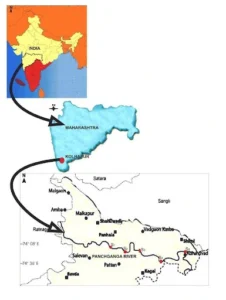
- Course and Confluence:
-
- The Panchaganga River flows and concludes into the Krishna River at Kurundvad, Maharashtra.
-
- Geography and Agriculture:
-
- The valley of the Panchaganga River is very fertile, with sloping banks that yield rich crops during the winter season.
- The Panchaganga and its feeders are fordable during the hot season.
-
- Environmental Concerns:
-
- In recent years, the pollution level of the Panchaganga River has been increasing rapidly.
- The primary cause of pollution is the disposal of untreated municipal sewage from Kolhapur town.
-
Chandravalli Cave
- News: The remains of ancient dynasties illuminate the dark interiors of the Chandravalli cave complex in Chitradurga district, Karnataka.
- Location:
-
- It is located in Chitradurga district of Karnataka.
- It is also known as the Ankali Math, named after a saint from Ankalagi in Belagavi district who is believed to have settled here.
-
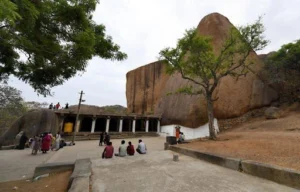
- Features:
-
- It is a pre-historic site which is semilunar in shape.
- The cave complex has several chambers, including a puja place with a shivlinga, a drawing room, a bedroom, and a water outlet that connects to an internal tank.
- There is a rock inscription of King Mayurasharma, the founder of the first Kannada dynasty, the Kadambas, dating back to 450 CE.
- A rock inscription can be found in the Bhairaweshwara temple at Chandravalli. Stone carvings indicate both Hindu and Buddhist influences.
- Excavations have revealed coins, painted bowls, and earthen pots dating back to various dynasties such as the Hoysala, the Satavahana, and the Vijayanagara.
- The region had historical connections with Rome and China, as evidenced by some of the coins discovered.
- Some of the walls are adorned with paintings created using organic paint.
- Findings and some inscriptions found in the surrounding areas of this sire reveal that Chandravalli has been home to human habitation ever since the megalithic age and neolithic age.
-
- Mythological Significance:
-
- Chandravalli was earlier known as Chandanavati.
- Mythology has it that this place was once ruled by Chandrahasa, a king of Kuntala. The name, Chandravalli, is attributed to this king by some scholars.
- Another explanation has it that the place was named Chandravalli because it was moon shaped.
-
Read also: UPSC Current Affairs: Gandaki River, BBPS, Uranium, Regenerative Braking & More
Order of Saint Andrew
- News: Prime Minister Narendra Modi has been awarded the Order of Saint Andrew the Apostle, during his visit to Russia.
- Definition:
-
- The Order of Saint Andrew the Apostle is Russia’s highest civilian honour.
-
- Establishment:
-
- It was established in 1698 by Tsar Peter the Great in honor of Saint Andrew, the first apostle of Jesus and patron saint of Russia.
- It was bestowed in a single class and was only awarded for the most outstanding civilian or military merit.
-
- Criteria and Recipients:
-
- The award is given to prominent government figures, military leaders, and outstanding representatives of science, culture, art for exceptional services to Russia.
- It is awarded to heads of foreign states for outstanding services to the Russian Federation.
- Prime Minister Narendra Modi was honoured with this award, highlighting the deep foundation of friendship between India and Russia.
-
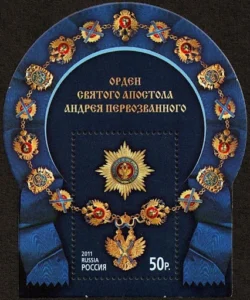
- Symbolism and Design:
-
- The chain of the Order consists of 17 alternating links, featuring a gilded image of the State Emblem of the Russian Federation, a double-headed eagle.
- It also includes a badge, a star, and a light blue silk moire ribbon.
- For those recognised for distinction in combat, the badge and star are adorned with swords.
-
- Other International Awards Bestowed Upon PM Modi:
| Grand Cross of the Legion of Honour | France |
| Order of Nile | Egypt |
| Grand Companion of the Order of Logohu | Papua New Guinea |
| Companion of the Order of Fiji | Fiji |
| Order of the Druk Gyalpo | Bhutan |
| Legion of Merit | US |
| Order of Zayed Award | United Arab Emirates |
| Order of Ghazi Amir Amanullah Khan | Afghanistan |
| King Abdulaziz Sash | Saudi Arabia |
| Grand Collar of the State of Palestine Award | Palestine |
UPSC GS 2
Project PARI (Public Art of India)
- News: The Ministry of Culture has initiated Project PARI for the 46th World Heritage Committee Meeting.
- More on News: The 46th Session of the World Heritage Committee Meeting is being held in New Delhi from 21st-31st July 2024.
- Overview:
-
- It is an initiative by the Ministry of Culture, Government of India.
- It is being executed by Lalit Kala Akademi and the National Gallery of Modern Art.
-
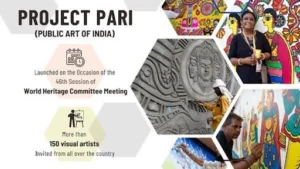
- Aim:
-
- To showcase public art inspired by India’s artistic heritage (lok kala/lok sanskriti) while incorporating modern themes and techniques.
- Highlights the intrinsic value of art in Indian society, reflecting the nation’s commitment to creativity and artistic expression.
-
- Proposed Sculptures: The proposed sculptures being created for Project PARI include nature, Natyashastra, Gandhi ji, toys of India, hospitality, ancient knowledge, Naad or Primeval Soun, Harmony of life, Kalpataru – the divine tree.
Classical Language Criteria
- News: Amid demand for classical status for many languages, the Union government has decided to modify the criteria for giving the special tag.
- Criteria for Declaring a Language as Classical
-
- Antiquity: The language must have early texts or recorded history spanning 1500-2000 years.
- Literary Heritage: The language should have a body of ancient literature or texts considered valuable heritage by generations of speakers.
- Original Literary Tradition: The literary tradition should be original and not borrowed from another speech community.
- Distinctiveness: The classical language and its literature should be distinct from the modern form. There may be a discontinuity between the classical language and its later forms or offshoots.
-
- Languages with Classical Status:
-
- Tamil: Declared in 2004.
- Sanskrit: Declared in 2005.
- Kannada: Declared in 2008.
- Telugu: Declared in 2008.
- Malayalam: Declared in 2013.
- Odia: Declared in 2014.
-
- Advantages of Classical Language Status:
-
- Awards: Two major annual international awards for scholars of eminence in classical Indian languages.
- Centres of Excellence: Establishment of a Centre of Excellence for studies in Classical Languages.
- Academic Support: The University Grants Commission is requested to create a certain number of Professional Chairs for the Classical Languages, at least in the Central Universities.
-
UPSC GS 3
Graphene
- News: It has been in the news.
- Definition:
-
- Graphene is a single layer (monolayer) of carbon atoms, tightly bound in a hexagonal honeycomb lattice.
-
- Properties:
-
- Graphene is an allotrope of carbon, along with diamond and graphite.
- It is a two-dimensional material.
- Graphene is the world’s thinnest material.
- It is stronger than diamond, more conductive than silver, more elastic than rubber, and lighter than aluminium.
- It is an excellent conductor of heat and electricity. It conducts electricity better than copper.
- It is almost transparent, as it absorbs only 2% of light.
- It is impermeable to gases, even those as light as hydrogen and helium.
-
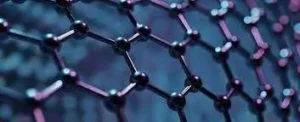
- Uses:
-
- As graphene is also strong and light, it means that it is a great material for making heat-spreading solutions, such as heat sinks or heat dissipation films.
- Graphene is a very promising material for use in batteries and supercapacitors.
- Graphene is used in anti-corrosion coatings and paints, efficient and precise sensors, faster and efficient electronics, flexible displays, efficient solar panels, faster DNA sequencing, drug delivery, etc.
-
UN High Seas Treaty (Biodiversity Beyond National Jurisdiction (BBNJ)
- News: The Indian government might soon sign and ratify the High Seas Treaty.
- Definition:
-
- The BBNJ Agreement, or the ‘High Seas Treaty’, is an international treaty under the United Nations Convention on the Law of the Sea (UNCLOS).
- It is also known as the ‘Paris Agreement for the Ocean.’
-
- Aim:
-
- It is a legally binding treaty that aims to protect marine biodiversity.
-
- Objectives:
-
- Conservation and protection of marine ecology;
- Fair and equitable sharing of benefits from marine genetic resources;
- Establishment mandatory environmental impact assessments for any activity damaging to the marine ecosystem;
- Capacity building and transfer of marine technologies to developing countries.
-
- UNCLOS:
-
- The United Nations Convention on the Law of the Sea is an international treaty that was adopted in 1982.
- It defines the rights and duties of nations regarding activities in the oceans.
- Demarcations of territorial waters and EEZs are a result of UNCLOS.
- India became a signatory to the UNCLOS in 1982.
-
- Highlights of the BBNJ Treaty:
-
- Marine Protected Areas (MPAs): Protection and conservation of marine ecology are achieved through the demarcation of Marine Protected Areas (MPAs).
- Environmental Impact Assessments (EIAs): The treaty mandates carrying out a prior EIA for activities that might pollute marine ecosystems.
- Goals and Commitments: The treaty aims to place 30% of the seas into protected areas by 2030.
- Fair Sharing of Benefits: This includes sharing scientific information and monetary benefits through a “clearing house mechanism”.
- Capacity Building and Marine Technology: The Scientific and Technical Body will play a significant role in environmental impact assessment, creating standards and guidelines for assessment procedures.
-
- What Are High Seas?
-
- The high seas are the maritime area that lies beyond the areas under the jurisdiction of States.
- The high seas are open to all States, whether coastal or land-locked.
- The high seas aren’t included in the exclusive economic zone, the territorial sea, or the internal waters of a country.
- Internal Waters: Covers all water and waterways on the landward side of the baseline where the State can set laws, regulate use, and use any resource.
- Territorial Waters: Extend up to 12 nautical miles from the baseline where the coastal State is free to set laws, regulate use, and use any resource.
- Contiguous Zone: Extends further 12 nautical miles beyond the territorial waters. The State can enforce laws in customs, taxation, immigration, and pollution.
-
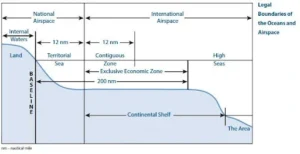
-
-
- Exclusive Economic Zones (EEZs): EEZs extend up to 200 nautical miles from the baseline, where the coastal nation has sole exploitation rights over all natural resources.
-
Biligiri Rangaswamy Temple Tiger Reserve (BRT)
- News: A tiger was found dead in the Kollegal Wildlife Division of Biligiri Ranganathaswamy Temple (BRT) Tiger reserve recently.
- Location:
-
- Located in Chamarajanagar district, Karnataka State.
- Situated at the confluence of the Western and Eastern Ghats, forming a unique bio-geographical habitat.
-
- Name and Significance:
-
- Named ‘Biligiri’ after the white rocky cliff that features a temple dedicated to Lord Vishnu, locally known as ‘Rangaswamy’.
- Declared a Tiger Reserve in 2011, covering an area of 574.82 sq.km.
-
- Vegetation:
-
- Predominantly dry deciduous forests.
- Includes moist deciduous, semi-evergreen, evergreen, and shola patches at different altitudes.
-
- Flora: Anogeissus latifolia, Dalbergia paniculata, Grewia teliaefolia, Terminalia alata, Terminalia bellirica, and Terminalia paniculata.
- Fauna: Tigers, elephants, leopards, wild dogs, bison, sambar, spotted deer, barking deer, four-horned antelope, sloth bears, wild boars, common langurs, and bonnet macaques.
See this: Pro Tem, Speaker, and Deputy Speaker of Lok Sabha | UPSC
Mitochondrial Diseases
- News: Researchers find weaker immune response to viral infections in children with mitochondrial disorders.
- Mitochondria:
-
- A mitochondrion is an organelle found in the cells of most eukaryotes, such as animals, plants and fungi.
- Mitochondria are often referred to as the powerhouses of the cell.
- The job of mitochondria is to process oxygen and convert substances from the foods you eat into energy.
- Mitochondria exist in nearly every cell in the human body.
- Mitochondria produce 90% of the energy our bodies need to function.
-
- Mitochondrial Disease:
-
- A group of diseases that affect mitochondria’s capacity to produce the energy organs need to function properly is known as mitochondrial disease (or Mito).
- Any organ can be affected, but the heart, brain, and muscles are more frequently impacted due to their high energy requirements.
-
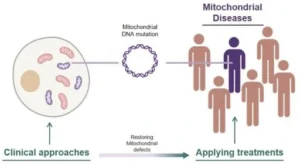
- Types of Mitochondrial Disease:
-
- Nuclear DNA Fault: Caused by faulty genes in the nuclear DNA, which is inherited from both parents.
- Mitochondrial DNA Fault: Caused by faulty genes in the mitochondrial DNA, which is inherited only from the mother.
-
- Symptoms:
-
- Mitochondrial disease in childhood often involves multiple organs, progresses quickly, and can have severe outcomes.
- Sometimes only one organ, tissue, or cell type is affected. But often, the problem affects many of them.
- Muscle and nerve cells have especially high energy needs, so muscular and neurological problems are common.
-
- Causes:
-
- Mitochondria are unique in that they have their own DNA called mitochondrial DNA, or mtDNA.
- Mutations in this mtDNA or mutations in nuclear DNA (DNA found in the nucleus of a cell) can cause mitochondrial disorder.
- Environmental toxins can also trigger mitochondrial disease.
- A lack of energy production from mitochondria in your cells causes mitochondrial disease.
-
- Treatment:
-
- There are no cures for these diseases, but treatments may help with symptoms and slow down the disease.
-
- Mitochondrial Donation:
-
- Mitochondrial donation is an IVF-based method that allows individuals with faulty mitochondrial DNA to have genetically related children without passing on the faulty DNA.
-
Sentinel Nuclear Missile
- News: The US Sentinel missile program is facing skyrocketing costs and possible program cuts.
- Overview:
-
- The Sentinel Nuclear Missile, designated as LGM-35A Sentinel, is an intercontinental ballistic missile (ICBM).
- The L in LGM stands for silo-launched, G means surface attack while M stands for guided missile.
- It is currently being developed by Northrop Grumman in collaboration with the Air Force Global Strike Command for the US Air Force (USAF).
-
- Replacement of Minuteman III:
-
- The Sentinel will replace the aging fleet of 400 LGM-30 Minuteman III ICBMs, which have been in service since the 1970s.
-
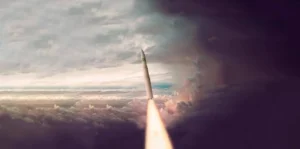
- Technological Advancements:
-
- The LGM-35A Sentinel will incorporate digital engineering technologies.
- It will employ a modular open system architecture, providing interoperability and reducing life-cycle costs.
- The missile will feature fully integrated launch, flight, and infrastructure systems, along with modern command and control technology and ground equipment.
-
- Warhead and Launch Capabilities:
-
- The Sentinel will be equipped with a W87-1 thermonuclear missile warhead.
- It will be launched from silos, with silo doors capable of remaining closed during warhead maintenance, thereby eliminating any security threat.
-
- Range and Targeting:
-
- The missile is expected to have a range exceeding 5,500 km.
- It can reach any target across the world within 30 minutes post-launch, following a parabolic trajectory toward its target.
-

